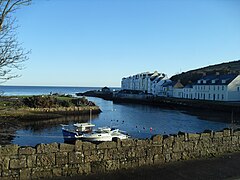Cushendun
| Cushendun | |
|---|---|
 |
|
| Cushendun shown within Northern Ireland | |
| Population | 138 (2001 Census) |
| District | |
| County | |
| Country | Northern Ireland |
| Sovereign state | United Kingdom |
| Post town | BALLYMENA |
| Postcode district | BT44 |
| Dialling code | 028 |
| EU Parliament | Northern Ireland |
| UK Parliament | |
| NI Assembly | |
Cushendun (from Irish Cois Abhann Duinne, meaning 'beside the River Dun') is a small coastal village in County Antrim, Northern Ireland. It sits off the A2 coast road between Cushendall and Ballycastle. It has a sheltered harbour and lies at the mouth of the River Dun and Glendun, one of the nine Glens of Antrim. The Mull of Kintyre in Scotland is only about 15 miles away across the North Channel and can be seen easily on clear days. In the 2001 Census it had a population of 138 people. It is part of Causeway Coast and Glens district.
The nearby hamlet of Knocknacarry is located approximately 0.6 miles to the west.
Cushendun village, was designed for Ronald McNeill, the Conservative MP and author later Lord Cushendun in the style of a Cornish village by the architect Clough Williams-Ellis. He is buried in the Church of Ireland graveyard near his nationalist cousin Ada or Ide McNeill, Roger Casement's friend and admirer who died in 1959.
Since 1954 most of the village and the parkland around Glenmona to the north has been owned by the National Trust. Cushendun's picturesque coastal setting in the heart of the Antrim Coast and Glens Area of Outstanding Natural Beauty, together with its unique architectural inheritance, resulted in designation as a Conservation area in 1980.
...
Wikipedia

